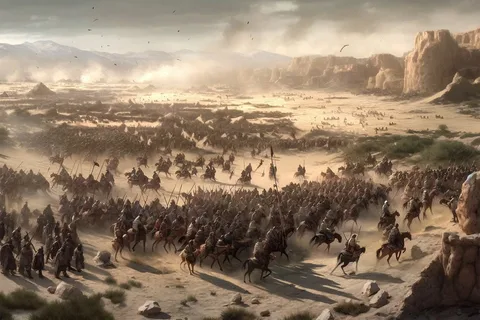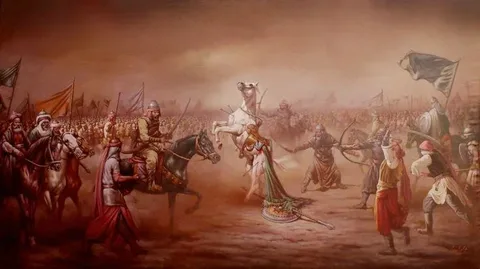The Battle of Bani Al-Mustaliq took place in the 5th year of Hijri (626 CE), during the month of Sha’ban. It was a military campaign led by Prophet Muhammad against the Arab tribe of Banu Mustaliq, a sub-clan of the larger Banu Khuza’a tribe. Banu Mustaliq controlled an important route near Mecca and had allied with the Quraysh against the Muslims. Intelligence reached the Prophet that Banu Mustaliq was preparing to attack the Muslim community, prompting a preemptive strike.
Background and Causes
Banu Mustaliq had participated alongside the Quraysh during the Battle of Uhud against the Muslims. Their control of the main road to Mecca acted as a barrier preventing Muslim access to the city. The tribe also had a history of inciting hostility and planning attacks against the Muslims. After receiving reports from a reconnaissance mission, Prophet Muhammad mobilized around 700 fighters with 30 horses to confront the threat before it materialized.
Read more: The battle of Bani Al-Nadir (4 Hijri)
the Battle of Bani Al-Mustaliq
The Muslim force approached the Banu Mustaliq near a watering place called al-Muraysi‘, where the tribe was watering their cattle. The Muslims launched a surprise attack that caught the tribe unprepared. The battle involved an intense exchange of arrows followed by a swift Muslim charge that led to the defeat of Banu Mustaliq. Many of their allies fled the scene before the fight began. The Muslims killed some fighters, captured others, and took a large quantity of booty including livestock and women prisoners.
Juwayriyah’s Marriage and Its Impact
Among the captives was Juwayriyah bint al-Harith, daughter of the Banu Mustaliq chief. She initially was owned by a Muslim companion but requested help from the Prophet. In an act of mercy and diplomacy, Prophet Muhammad married Juwayriyah. This marriage led to the freeing of many prisoners from her tribe who then embraced Islam. The act helped to ease tensions and fostered good relations between the Muslims and the Banu Mustaliq.
Internal Challenges During the Campaign
Tensions almost arose between the Muhajirun (emigrants from Mecca) and the Ansar (native helpers from Medina) during the return march when a quarrel broke out between two Muslims over water. These tensions were fueled by the hypocrites (Munafiqun) within the Muslim ranks aiming to cause division. Prophet Muhammad quickly diffused the situation by ordering the army to keep marching day and night, preventing escalation of conflict. Shortly after, false accusations against Aisha, Muhammad’s wife, were revealed to be untrue through divine revelation.
Recommend: The battle of Bani Saleem (2 Hijri)
Significance and Lessons
The Battle of Bani Al-Mustaliq was crucial in consolidating Muslim control over a key access route and weakening enemy alliances. It illustrated the importance of intelligence, swift action, strong leadership, and diplomacy. The Prophet’s marriage to Juwayriyah exemplified transformation of adversaries into allies through compassion. The episode also highlighted the dangers of internal discord and hypocrisy, underscoring the need for unity in the Muslim community.
Read about: The battle of Domat-Ul-Gandal (5 Hijri).
FAQs
When did the Battle of Bani Al-Mustaliq take place?
The battle occurred in the 5th year of Hijri, during the month of Sha'ban (626 CE).
What was the main cause of the battle?
The Banu Mustaliq tribe was preparing to attack the Muslims and was allied with the Quraysh. The Muslims launched a preemptive strike to neutralize this threat.
Who was Juwayriyah bint al-Harith and what was her significance?
Juwayriyah was the daughter of the Banu Mustaliq chief, taken captive during the battle. She married Prophet Muhammad, which led to the freeing of many captives and strengthened Muslim relations with her tribe.
What internal issues arose during the campaign?
Tensions between the Muhajirun and Ansar nearly led to conflict, exacerbated by hypocrites within the Muslim ranks. The Prophet’s leadership helped defuse the situation and maintain unity.
What lessons can be learned from the Battle of Bani Al-Mustaliq?
Key lessons include the importance of strategic planning, leadership in uniting communities, mercy towards former enemies, and vigilance against internal discord and hypocrisy.
Conclusion
The Battle of Bani Al-Mustaliq was a pivotal moment in early Islamic history, securing the Muslim presence along a crucial route and weakening a potential enemy alliance with the Quraysh. Beyond the military victory, it showcased the Prophet Muhammad’s leadership in combining strategy, mercy, and diplomacy to integrate former adversaries into the Muslim community. The resolution of internal tensions affirmed the necessity of unity and vigilance within the nascent Muslim society. Ultimately, this battle strengthened the Muslim community’s position and expanded its influence in the Arabian Peninsula.


